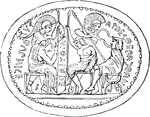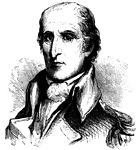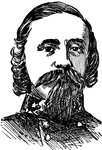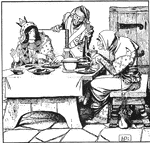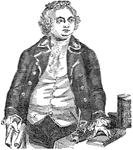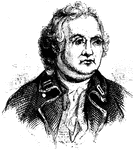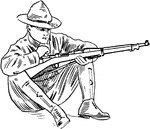Parade Rest
"Carry the right foot 6 inches straight to the rear, left knee slightly bent; clasp the hands, without…
Parade Rest with Rifle
"Carry the right foot 6 inches straight to the rear, left knee slightly bent; carry the muzzle in front…

High Parry
"Raise the rifle with both hands high enough to clear the line of vision, barrel downward, point of…

Low Parry
"Carry the point of the bayonet down until it is at the height of the knee, moving the point of the…

Low Parry
"These parries are rarely used, as an attack below the waist leaves the head and body exposed." —…

Paul is Beheaded at Rome by the Order of Emperor Nero
Illustration of Paul, kneeling on one knee in the city streets, head bowed, awaiting execution. A man…

Paul is Shipwrecked on Malta
"But lighting upon a place where two seas met, they ran the vessel aground; and the foreship struck…
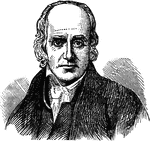
Charles Wilson Peale
Charles Willson Peale (April 15, 1741 – February 22, 1827) was an American painter, soldier and…
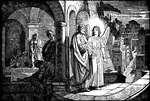
Peter Emerges from Prison after Being Saved by an Angel
"And he went out, and followed; and he knew not that it was true which was done by the angel, but thought…
Port Arms
"With the right hand raise and throw the piece diagonally across the body, grasp it smartly with both…

Peter Buel Porter
Peter Buell Porter (August 14, 1773 – March 20, 1844) was an American lawyer, soldier and politician…
Present Arms
"With the right hand carry the piece in front of the center of the body, barrel to the rear and vertical,…

Quick Time
The signal to march at the faster pace of 'quick time.' The Royal Navy marches at a cadence of 116 paces…
![Sir Walter Raleigh or Ralegh[1] (c. 1552 – 29 October 1618), was a famed English writer, poet, soldier, courtier and explorer.](https://etc.usf.edu/clipart/62500/62593/62593_w-raleigh_mth.gif)
Sir Walter Raleigh
Sir Walter Raleigh or Ralegh[1] (c. 1552 – 29 October 1618), was a famed English writer, poet, soldier,…
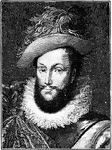
Sir Walter Raleigh
Sir Walter Raleigh or Ralegh (c. 1552 – 29 October 1618), was a famed English writer, poet, soldier,…

Range or Change Elevation
"To announce range, extend the arm towar the leaders or men for whom the signal is intended, fist closed;…
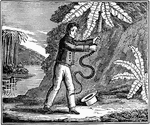
Conflict with a Rattlesnake
Conflict with a rattlesnake. Caption below illustration: "The snake when about a yard distant, made…
Rifle Salute
"Carry the left hand smartly to the small of the stock, forearm horizontal, palm of hand down, thumb…
Rifle Salute
"Carry the left hand smartly to the right side, palm of the hand down, thumb and fingers extended and…

Left-Handed Rifle
"As additional instruction, the men may be permitted to wield the rifle left handed, that is on the…
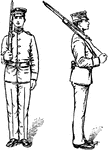
Right Shoulder, Arms
"Without changing the grasp of the right hand, place the piece on the right shoulder, barrel up and…

A Roman Legionary
"From a monument of the imperial age. The soldier wears a metal helmet, a leather doublet with shoulder-pieces,…

Roman Soldiers
The distinction between rank and unit type doesn't seem to have been as precise as in a modern-day army,…

A Roman Standard-Bearer called an Aquilifer
Illustration of an aquilifer carrying the eagle standard for his Roman legion. His left hand sits on…

Roman Tent
"The Roman soldiers seem to have used two sorts of tents, one, a tent proper, of canvas or some analogous…

Edmund Ruffin
Edmund Ruffin (January 5, 1794 – June 18, 1865) was a farmer and slaveholder, a Confederate soldier,…

Prince Rupert of the Rhine
Rupert, Count Palatine of the Rhine, Duke of Bavaria, commonly called Prince Rupert of the Rhine, (17…
Saber Return
"Officers and noncomissioned officers armed with the saber, when mounted, return saber without using…
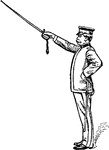
Drawn Saber
"When publishing orderes, calling the roll, etc., the saber is held suspended from the right wrist by…

Drawn Saber
"When arms are brought to the order the officers or enlisted men with the saber drawn order saber."…

Saint George
This sculpture by the great artist, Donatello, is of a man dressed in armor holding a shield in front…

Salute
"Raise the right hand smartly till the tip of the forefinger touches the lower part of the headdress…
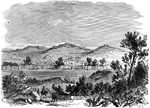
Saratoga and Stillwater - Encampments of Burgoyne's Army
Encampments of Burgoyne's army, Saratoga and Stillwater.

Saul's Conversion on the Road to Damascus
"And as he journeyed, it came to pass that he drew nigh unto Damascus: and suddenly there shone round…
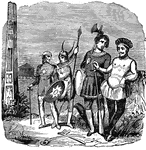
Saxons
"In the eleventh century, the Anglo-Saxons, originally the fiercest nation of the North of Europe, had…

Lieutenant General Winifred Scott
Lieutenant General Winifred Scott, a long-serving US Army officer who ran unsuccessfully for president…

Section
Signal to inform the troops that the next signal will be directed at a certain 'section' rather than…
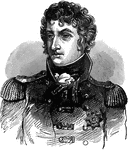
Sir John Coape Sherbrooke
Sir John Coape Sherbrooke (baptised April 29, 1764 – February 14, 1830) was a British soldier…
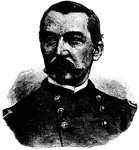
Philip H. Sheridan
(1831-1888) Union soldier who forced out the Confederates from the Shenandoah Valley

General Philip Henry Sheridan
(1831-1888) Philip Sheridan was a United States Army officer and Union General in the Civil War.

General Sherman
William Tecumseh Sherman (February 8, 1820 – February 14, 1891) was an American soldier, businessman,…
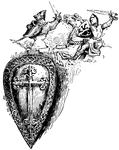
Medieval Shields from the 13th and 14th Centuries
Illustration including one large shield from the first half of the 13th century, bearing a decorative…
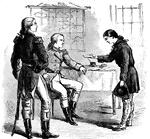
Deborah Simpson Presenting the Letter to General Washington
Woman who masqueraded as a male soldier presenting a letter to General Washington.
